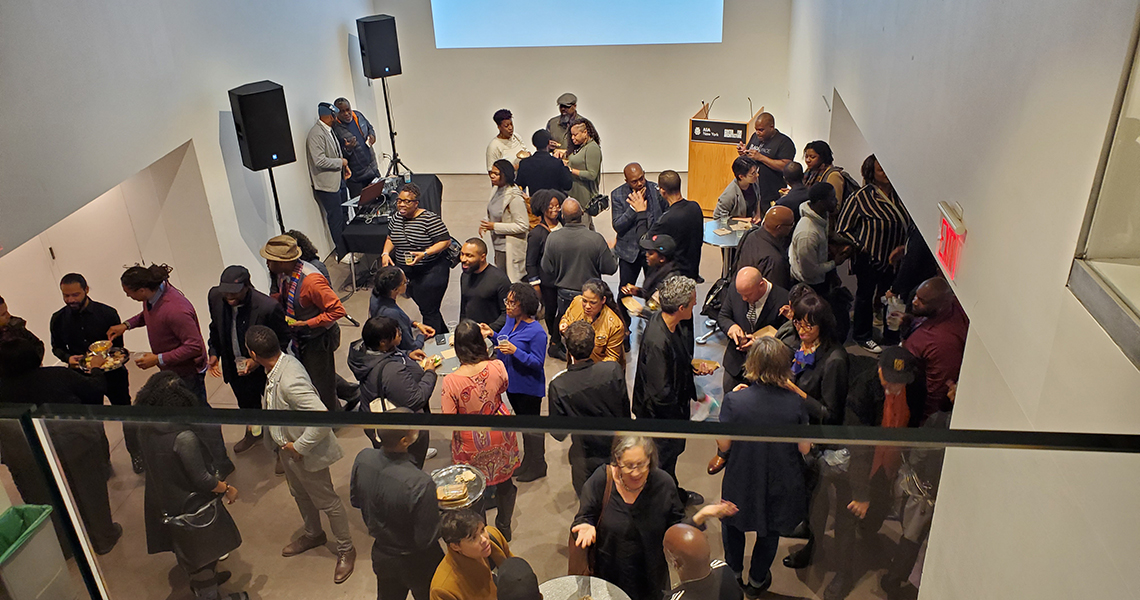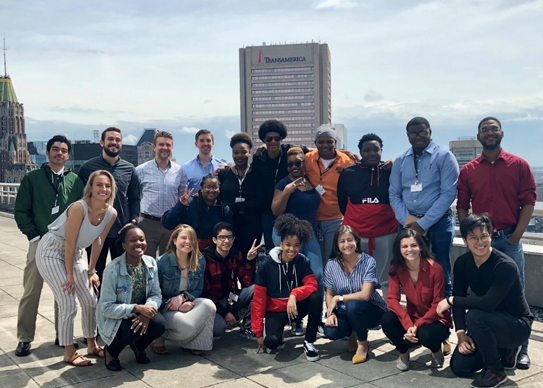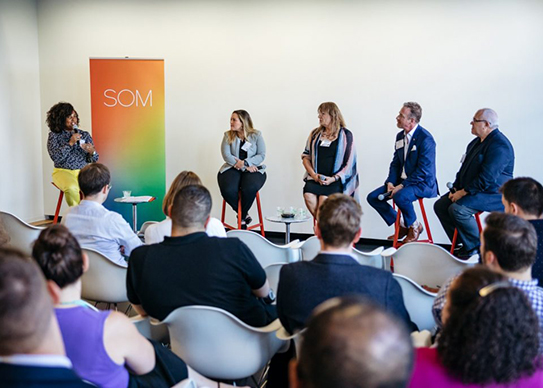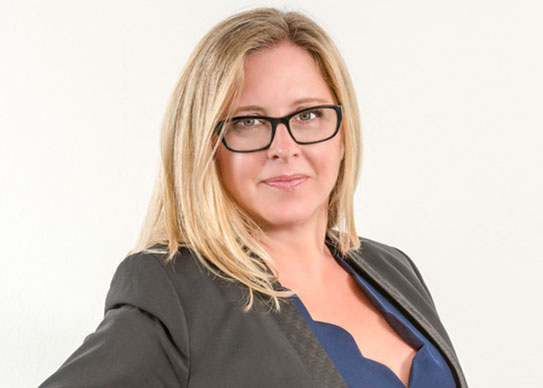NOMA is an industry organization championing diversity within the design profession – with an emphasis on racial diversity. A strategic partner to the American Institute of Architects (AIA), its chapters across the country play a key role in helping our profession create a more diverse future.
To share some of the key takeaways from the conference, we put together the following Q&A. We hope you’ll take some time to read our thoughts. There is so much we can all learn from the lectures and events that unfolded at this year’s NOMA conference.

This year’s theme was “Believe the Hype: A Global Collective of Industry Change Agents.” What does that theme mean to you, and how did the theme come alive at the conference?
Guadalupe: Keynote speaker, Allison Williams, FAIA, eloquently explained the difference between hype and the hype. As a noun, hype means extravagant or intensive publicity or promotion. However, as a verb, hype means to promote or publicize a product or idea intensively, often exaggerating its importance or benefits. As professionals, we must be conscious of language and the power of words. After attending the conference, I, too, believe in the hype. The theme came alive after attending the lectures and meeting several movers and shakers within our industry.
Briana: The theme came alive via the strong sense of pride, joy and community that the attendees and presenters had for their local NOMA chapters, firms, project work, communities, career experience and/or architectural discourse. For me, it’s not every day that I see and can learn from this medley of powerfully diverse architects of varying levels within the AEC profession all at once. So, even as an African American female architect, I was amazed by “the hype” of so many minority architects gathered so accessibly in one space. I left the conference feeling encouraged and reassured that successful and impactful minority architects do exist globally.
What were your favorite events or lectures?
Briana: One of my favorite lectures was given by Murray Miller – “Truth or Consequences: How the Nation’s Only Purpose-Built KKK Site of Painful Memory Might Encourage Community Well-being.” Interestingly, what intrigued me most was the Q &A session that followed the lecture, as many attendees spoke passionately for and against why architecture that symbolizes dark and hateful moments in history should or shouldn’t be preserved in the built environment. Not only was there another historical preservationist in the room who critiqued the speaker’s argument for the preservation of this KKK site, but once the lecture ended, another informal lecture among attendees formed outside in the hallway to discuss their stances further. Now that’s architecture.
Another inspiring lecture was “The Making of The Universal Hip Hop Museum” by Michael Ford. Michael leads the Hip-Hop Architecture summer camps that are held throughout the U.S. to engage kids in architecture through music. As someone who regularly engages with youth through community involvement, I was inspired by the way he leads the camps by using spatial mediums that youth recognize and can immediately relate to. One exercise he leads is projecting album covers with a silhouette of the artists on them, asking the kids to guess who the artist is. How does this relate to architecture? One, it establishes a sense of relationship with the group by meeting the youth at a familiar point. Two, it’s a figure/ground exercise that many architects learned in school to explain the solid vs. void relationship. Once this connection is made with youth, it’s easier to dig deeper into spatial activities about solid vs. void in a familiar built environment.

Guadalupe: I particularly enjoyed attending the lectures on design and finance. In college, I earned a bachelor’s degree in architecture and a minor degree in business administration, and I did a major in architecture with a concentration in real estate in grad school. I feel like I have a balanced approach in my profession that can relate to both the design (left hemisphere) and the numbers (right hemisphere).
Two memorable lectures were “Finance: The Nth Sense of Design” and “Queen, Don’t Be Afraid to Rule Like a King.” The first lecture taught me that everyone on a team should know the numbers affecting a project, including compensation, hours spent on the project, and their utilization rate. The speaker also highlighted the importance of getting the firm’s accountants involved in project meetings. The latter lecture taught me that it’s ok not to have a career path or career goals as long as you move forward and become an expert in each position; it also emphasized the importance of trusting gut feelings and having the courage to follow your business ideas.
 Personally, what was the overall conference experience like?
Personally, what was the overall conference experience like?
Briana: It felt surreal at times to be, for once, a part of the majority in the AEC profession. Throughout the conference, I made a conscious effort to bask in the atmosphere and network with over 1,000 people of color and female architects – a mentorship opportunity that is hard to find once outside the walls of NOMA. So much inspiration and expertise engulfed me to the point that upon the closing of the conference, as I was headed back to Penn Station to catch my train to Baltimore, I was overwhelmed with emotion as I felt inspired, encouraged, and sad to be leaving such an awe-inspiring and safe space.
Guadalupe: Being at the conference felt like attending a school reunion. NOMA is a tight-knit community, and the camaraderie was apparent through all the events. As a newcomer to NOMA and CannonDesign, it felt a bit overwhelming in the beginning because it seemed like everybody already knew each other, but at the end of the conference, I felt like part of the community. It was incredibly inspiring to be surrounded by so much diverse talent. Once you see someone like you doing great things in their professions, you too feel like you can do it.
What are some key lessons/pieces of advice you took away from the event you think others in the firm could learn from?
Briana: Some of my favorite takeaways are best captured in quotes I wrote down from a few of the speakers:
- “Don’t apologize for how you chose to rule.” –Kalilah Wright
- “A business owner without a defined exit strategy does not own a business, they, in fact, own a very expensive job with a significant amount of risk.” –Barry Queen
- “There is something therapeutic about doing something by yourself after doing so many things with others.” –Kalilah Wright
Guadalupe:
- When you don’t speak up, you are allowing other people to make decisions for you. The truth can be uncomfortable, but you must push forward to trigger change.
- Find your tribe at work and support each other. This group of people can help advocate for each other and help achieve work-life balance initiatives.
- Become an expert in every job that you do because you never know how those skills will serve you in your next position or business.
In what ways do you think design firms can better inspire and engage with current and future minority architects?
Briana: Engaging first-hand with Historically Black Colleges and Universities (HBCUs) or NOMAS [“s” for student] chapters is fundamental. A personal highlight of the conference was witnessing the Syracuse University NOMAS chapter win 1st Place in the Student Design Competition. As an alum of the Syracuse University School of Architecture program, I thought to myself, what an even greater sense of pride I’d feel if I had a hand in critiquing and guiding student teams in achieving awards like this. There are so many opportunities for firms like ours to give back to local architecture studios and programs like NOMAS to offer access and mentorship to aspiring architects.

Briana with the Syracuse University NOMAS chapter
Guadalupe: This is a fundamental question for the AEC industry: Why is diversity in our industry important? We give a voice to the users of each project; having a homogeneous team is a disservice to the community. Any building is part of a community, so as a profession, we need to make sure the teams are diverse to allow for multiple points of view. CannonDesign and other firms need to continue to take part in initiatives aimed at attracting future minority designers/architects/engineers. Supporting and encouraging employees in participating in mentorship, such as ACE, is a step in the right direction. Another good program is NOMA’s Project Pipeline, which runs architecture camps and other activities for younger kids to foster the next generation of architects, planners, and change-makers.




